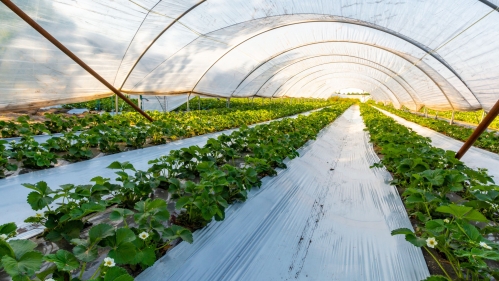Plastic use in agriculture must be reduced in order to mitigate pollution and prevent toxic chemicals from leaching into the soil and adversely affecting human health, according to a recently published study.
“Emerging data on leaching of toxic additives and tiny fragments from plastics called micro-nanoplastics into the water, ground, and air show impact on human health,” says Philip Demokritou, Henry Rutgers Chair and Professor at the Rutgers School of Public Health. “Petroleum-based plastics are not biodegradable and persist in the environment, with residues accumulating in the soil and can also be taken up by plants as they break into tiny plastic particles and enter our food chain via trophic transfer.”
In an article published in Nature Communications Earth & Environment, Demokritou outlines the benefits and risks of using plastics in agriculture and identifies sustainable solutions that can be used to protect the environment and safeguard public health.
He and an international team of authors found that it is essential to adopt a strategic approach that includes responsible usage, reduction, efficient collection, reuse and the implementation of innovative recycling methods, which are vital in mitigating plastic pollution stemming from plastic use in agriculture.
Demokritou said researchers suggest more sustainable approaches to using plastics in agriculture, like collecting, reusing and recycling plastics. When it is not possible to take this approach, “biodegradable and nontoxic bioplastics rather than petroleum-based plastics should be used to ensure complete biodegradation.”
While plastics play a crucial role in modern agricultural practices, serving various functions such as mulch films, nets, storage bins, and helping to increase the amount of food that is produced while decreasing the ecological resources used by controlling weeds and pests, preserving soil moisture, regulating temperature and improving nutrient uptake and plant growth, their extensive use has led to significant waste. The consequences on human and environmental health are also poorly understood.
Environmentally benign additives should be mandated to reduce toxicity, researchers insist. More than 10,000 chemicals are used to produce plastics, many of which have been outlawed because of their impact on human and environmental health. Demokritou says a shift towards the sustainable use of plastics will require that these materials are safe and also information regarding the chemicals used is accessible.
The researchers also say sustainable innovation must be linked to social processes. To reduce plastic pollution, farmer’s behavior, as well as availability of materials, production practices, and various constrains need to be considered.
Regulatory frameworks and incentives may be helpful. Scientists, members of the government, non-governmental organizations, and stakeholders agree that plastic pollution is problematic and needs to be addressed.
"To attain a greater level of sustainability in the utilization of plastics within the realm of plant agriculture, it will be essential to make informed decisions grounded in scientific knowledge and rooted in the principles of a circular economy. This entails fostering innovations in material design, enhancing the collectability of plastics post-use, promoting their reuse and recycling, and implementing shifts in usage practices,” concluded Demokritou.
Currently, Demokritou and his team are funded by United States Department of Agriculture to assess the impact of micro-nanoplastics on plants and human health.
Additional publications on the life cycle health implications of plastics and sustainable materials in the agriculture and food domain from the Rutgers Nanoscience and Advanced Materials Center:
-
Yang, Z et al. Micro- and nanoplastics (MNPs) and their potential toxicological outcomes: State of science, knowledge gaps and research needs. Nanoimpact,Vol. 32, 2023 https://doi.org/10.1016/j.impact.2023.100481.
-
DeLoid GM, et al.. Incineration-Generated Polyethylene Micro-Nanoplastics Increase Triglyceride Lipolysis and Absorption in an In Vitro Small Intestinal Epithelium Model. Environmental Science & Technology. 2022 August. 56 (17), 12288-12297. DOI: 10.1021/acs.est.2c03195. [link]
-
DeLoid GM, et al. Toxicity, uptake, and nuclear translocation of ingested micro-nanoplastics in an in vitro model of the small intestinal epithelium. Food and Chemical Toxicology. 2021 Dec. 158, 112609. [link]
-
Cary CM, et al.. Ingested Polystyrene Nanospheres Translocate to Placenta and Fetal Tissues in Pregnant Rats: Potential Health Implications. Nanomaterials. 2023 February. 13(4):720. https://doi.org/10.3390/nano13040720. [link]
-
Cary CM, et al. Single inhalation exposure to polyamide micro and nanoplastic particles impairs vascular dilation without generating pulmonary inflammation in virgin female Sprague Dawley rats. Part Fibre Toxicol. 2023 April. 20, 16. [link]
-
Tao Xu, et al. Enhancing agrichemical delivery and plant development with biopolymer-based stimuli responsive core-shell nanostructures. ACS Nano. 2022 April. 16 (4), 6034-6048. [link]
-
Cohen Y, et al. Quaternized chitosan as a biopolymer sanitizer for leafy vegetables: synthesis, characteristics, and traditional vs. dry nano-aerosol applications. Food Chemistry. 2022 June. 378, 132056. [link]
-
Zhao Z, et al. Sustainable Nutrient Substrates for Enhanced Seedling Development in Hydroponics. ACS Sustainable Chemistry & Engineering. 2022 June. 10 (26), 8506-8516. DOI: 10.1021/acssuschemeng.2c01668. [link]
-
Chang H, et al. High-throughput coating with biodegradable antimicrobial pullulan fibres extends shelf life and reduces weight loss in an avocado model. Nature Food. 2022 June. 3, 428–436 (2022). https://doi.org/10.1038/s43016-022-00523-w [link]
-
Aytac Z, et al.. Enzyme- and Relative Humidity-Responsive Antimicrobial Fibers for Active Food Packaging. ACS Applied Materials & Interfaces. 2021 Oct. 13 (42), 50298-50308. [link]
-
Xu T, et al. Enhancing agrichemical delivery and seedling development with biodegradable, tunable, biopolymer-based nanofiber seed coatings. ACS Sustainable Chem. Eng. 2020 June 5. 8(25):9537-48. [link]
-
Aytac Z, et al. Development of biodegradable and antimicrobial electrospun zein fibers for food packaging. ACS Sustainable Chem. Eng. 2020 Sept 21. 8(40):15354-65. [link]
-
Huang R, et al. A novel antimicrobial technology to enhance food safety and quality of leafy vegetables using engineered water nanostructures. Environmental Science: Nano. 2020 Dec 17. 8:514-26. [link]



